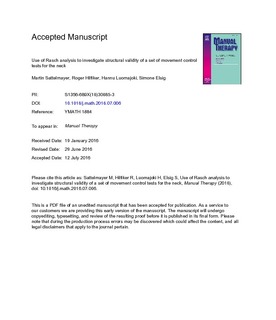Please use this identifier to cite or link to this item:
https://doi.org/10.21256/zhaw-1202Full metadata record
| DC Field | Value | Language |
|---|---|---|
| dc.contributor.author | Sattelmayer, Martin | - |
| dc.contributor.author | Hilfiker, Roger | - |
| dc.contributor.author | Luomajoki, Hannu | - |
| dc.contributor.author | Elsig, Simone | - |
| dc.date.accessioned | 2017-01-16T10:03:36Z | - |
| dc.date.available | 2017-01-16T10:03:36Z | - |
| dc.date.issued | 2016 | - |
| dc.identifier.issn | 2468-7812 | de_CH |
| dc.identifier.issn | 2468-8630 | de_CH |
| dc.identifier.uri | https://digitalcollection.zhaw.ch/handle/11475/1200 | - |
| dc.description | In press | de_CH |
| dc.description.abstract | Background: Movement control abilities are often reduced in persons with neck pain. In physiotherapeutic practice observational tests are frequently used to assess the impaired abilities. Several tests for movement control abilities are available, but no evidence exists on how to combine and interpret them. Objective: The aim was to investigate structural validity of a set of movement control tests with Rasch analysis. Design: Cross-sectional study Methods: Thirty persons with and thirty without neck pain were recruited for this study. All persons performed ten movement control tests. A partial credit model was applied to investigate item fit, ordering of the item response functions, dimensionality and hierarchy of the tests. Results: The majority of persons with neck pain had moderate disabilities and the mean value in the Neck disability index was 10.7. Functioning of the movement control tests to measure the construct “movement control abilities” was adequate for the majority of tests. Three movement control test showed considerable misfit. Possible explanations were a reactive movement control instead of an active control and a more challenging test position. Test difficulties and person abilities could be estimated for the complete sample. The most difficult test was “sitting rocking forward” (1.13 logits) and the least difficult test was “lifting the right arm” (-1.30 logits). The highest person ability estimate was 3.61 logits indicating that movement control tests are missing to evaluate persons with moderate neck disabilities. Conclusion: Modifying the existing set of tests is required to evaluate the complete spectrum of persons with neck pain. | de_CH |
| dc.language.iso | en | de_CH |
| dc.publisher | Elsevier | de_CH |
| dc.relation.ispartof | Musculoskeletal Science and Practice | de_CH |
| dc.rights | http://creativecommons.org/licenses/by-nc-nd/4.0/ | de_CH |
| dc.subject.ddc | 615.82: Physiotherapie | de_CH |
| dc.title | Use of Rasch analysis to investigate structural validity of a set of movement control tests for the neck | de_CH |
| dc.type | Beitrag in wissenschaftlicher Zeitschrift | de_CH |
| dcterms.type | Text | de_CH |
| zhaw.departement | Gesundheit | de_CH |
| zhaw.organisationalunit | Institut für Physiotherapie (IPT) | de_CH |
| dc.identifier.doi | 10.21256/zhaw-1202 | - |
| dc.identifier.doi | 10.1016/j.math.2016.07.006 | de_CH |
| zhaw.funding.eu | No | de_CH |
| zhaw.originated.zhaw | Yes | de_CH |
| zhaw.publication.status | acceptedVersion | de_CH |
| zhaw.volume | 27 | de_CH |
| zhaw.embargo.end | 2017-07-21 | de_CH |
| zhaw.publication.review | Peer review (Publikation) | de_CH |
| Appears in collections: | Publikationen Gesundheit | |
Files in This Item:
| File | Description | Size | Format | |
|---|---|---|---|---|
| Sattelmeier et al 2016.pdf | Accepted Version | 451.58 kB | Adobe PDF |  View/Open |
Show simple item record
Sattelmayer, M., Hilfiker, R., Luomajoki, H., & Elsig, S. (2016). Use of Rasch analysis to investigate structural validity of a set of movement control tests for the neck. Musculoskeletal Science and Practice, 27. https://doi.org/10.21256/zhaw-1202
Sattelmayer, M. et al. (2016) ‘Use of Rasch analysis to investigate structural validity of a set of movement control tests for the neck’, Musculoskeletal Science and Practice, 27. Available at: https://doi.org/10.21256/zhaw-1202.
M. Sattelmayer, R. Hilfiker, H. Luomajoki, and S. Elsig, “Use of Rasch analysis to investigate structural validity of a set of movement control tests for the neck,” Musculoskeletal Science and Practice, vol. 27, 2016, doi: 10.21256/zhaw-1202.
SATTELMAYER, Martin, Roger HILFIKER, Hannu LUOMAJOKI und Simone ELSIG, 2016. Use of Rasch analysis to investigate structural validity of a set of movement control tests for the neck. Musculoskeletal Science and Practice. 2016. Bd. 27. DOI 10.21256/zhaw-1202
Sattelmayer, Martin, Roger Hilfiker, Hannu Luomajoki, and Simone Elsig. 2016. “Use of Rasch Analysis to Investigate Structural Validity of a Set of Movement Control Tests for the Neck.” Musculoskeletal Science and Practice 27. https://doi.org/10.21256/zhaw-1202.
Sattelmayer, Martin, et al. “Use of Rasch Analysis to Investigate Structural Validity of a Set of Movement Control Tests for the Neck.” Musculoskeletal Science and Practice, vol. 27, 2016, https://doi.org/10.21256/zhaw-1202.
Items in DSpace are protected by copyright, with all rights reserved, unless otherwise indicated.